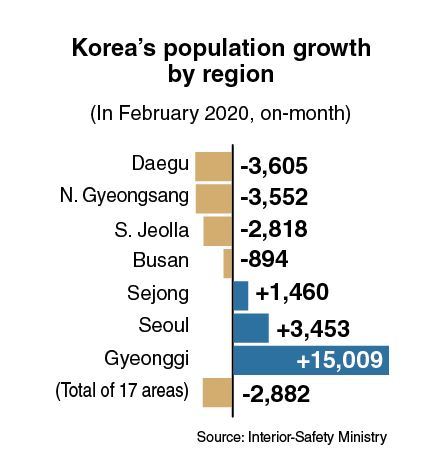[News Focus] South Korea’s population dips by 6,800 in 3 months
Daegu has sharpest fall in number of residents in February
By Kim Yon-sePublished : March 5, 2020 - 10:50

SEJONG -- South Korea continued to post a negative growth in population in February -- for an unprecedented third consecutive month.
According to the Ministry of Interior and Safety, the nation’s population declined by 2,882 as of February, compared to a month earlier, to post 51.844 million.
The pace of negative growth has increased since the nation entered the era of population decline in December 2019, when it fell by 1,566. The figure for January 2020 was minus 2,352.
Over the past three months, Korea saw the population slide by 6,800 from the peak of 51.851 million in November. The figure for men and women dropped by 6,113 and 687, respectively, for the corresponding period.
The government’s demographic data is compiled on the basis of monthly resident registration, which reflects figures for births, deaths and change in citizenship.
During the latter half of 2019, the nation’s long-standing positive growth in population continued to slow -- plus 2,976 in July, August (1,926), September (1,715), October (1,452), and November (722) -- signaling the so-called “demographic cliff” in the coming years and decades.
Formerly, the negative population growth was seen in the nation only twice -- in March 2008 and in April 2009. And for a decade between May 2009 and November 2019, the figure represented a continuous on-month increase.
Interior Ministry data showed that 13 of the 17 major areas (eight cities and nine provinces) recorded lower population figures in February.
Daegu topped the list as the figure fell by 3,605, followed by North Gyeongsang Province (3,552).

Daegu and contiguous North Gyeongsang Province are the nation’s seventh- and sixth-largest areas -- whose collective number of residents came to 5.09 million and accounted for 9.8 percent of the total population.
In addition to the residential outflow in the two neighboring Yeongnam regions, the novel coronavirus (COVID-19) is aggravating worries over the social and economic situation there. They were hit most in terms of the number of infections in Korea.
A Sejong citizen whose hometown is Daegu said that people in the metropolitan city had been vigorous in promoting the state-led “Year (2020) of Visit to Daegu and North Gyeongsang Province” local and inbound tourists until before the coronavirus-infection disaster came to the fore in February.
As the initial step, Daegu City invited about 1,000 students from China in January.
South Jeolla Province ranked third in the decrease with 2,818, trailed by South Gyeongsang Province (2,516), North Jeolla Province (2,190) and South Chungcheong Province (1,460).
Ulsan saw its population drop by 1,327, followed by Incheon (1,164), Daejeon (1,027), Gangwon Province (1,019), Busan (894), North Chungcheong Province (792) and Gwangju (567).
However, Seoul reversed the losing streak. The capital, which had seen a steady decline in its population since 2011, saw the number of its residents increase by 3,453 in February, posting a positive growth for the second consecutive month.
A demographic researcher estimated that the figure could be because more households are “moving or relocating their resident-registration addresses to Seoul for the education of their children, or seeking to benefit from the (inhabitant-based) apartment subscription as a housing-purchase strategy in the lucrative capital.”
The number of Seoul citizens recorded 9.736 million -- the second-largest area by population. But its disparity with Gyeonggi Province (the largest) has been widening, which posted a positive growth by 15,009 to an all-time high of 13.265 million last month.
Sejong (the smallest area among the 17 by population) and Jeju Province (second-lowest) also gained in the number of residents by 1,460 to 343,700 and by 127 to 670,800, repectively.
In February, the number of births was outstripped by deaths: 23,049 vs. 26,353. While the gap between the two was 3,304, citizenship changes -- Koreans renouncing their citizenship and foreigners acquiring Korean citizenship -- offset the population decline somewhat, for a total decline of 2,882.
Out of Koreans aged under 70, those under 10 years took up the lowest number with 4.13 million, while those aged 10-19 were second-lowest with 4.92 million.
In contrast, the number of those in their 50s (highest) tallied 8.66 million, followed by those in their 40s (8.39 million), 30s (7.02 million) and 60s (6.38 million).
Koreans aged 70 or over reached 5.52 million, outnumbering people in each of the two youngest age brackets (0-9 and 10-19).
The youth population, people aged 14 and below, made up 12.4 percent of the overall population in February, while their proportion reached 16.4 percent a decade earlier in February 2010.
By Kim Yon-se (kys@heraldcorp.com)











![[Today’s K-pop] BTS pop-up event to come to Seoul](http://res.heraldm.com/phpwas/restmb_idxmake.php?idx=644&simg=/content/image/2024/04/17/20240417050734_0.jpg&u=)




![[KH Explains] Hyundai's full hybrid edge to pay off amid slow transition to pure EVs](http://res.heraldm.com/phpwas/restmb_idxmake.php?idx=652&simg=/content/image/2024/04/18/20240418050645_0.jpg&u=20240418181020)

![[Today’s K-pop] Zico drops snippet of collaboration with Jennie](http://res.heraldm.com/phpwas/restmb_idxmake.php?idx=642&simg=/content/image/2024/04/18/20240418050702_0.jpg&u=)